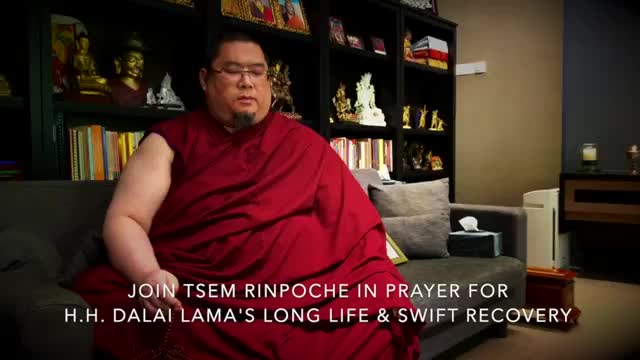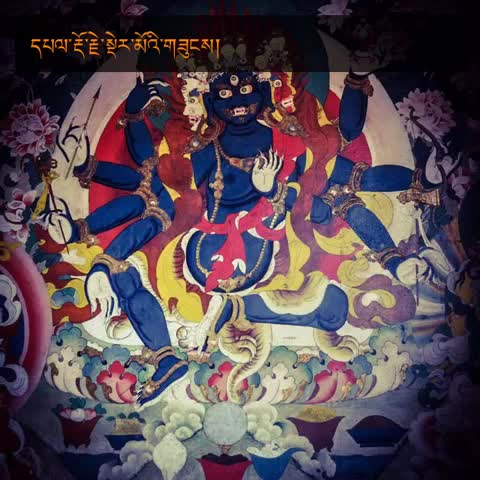Is negativity really negative?

(By Tsem Rinpoche and Pastor Niral)
We all go through some form of negativity throughout our lives, and that’s just how life in our world is. During such periods in our lives, we get so caught up in the negativity itself that we forget the fact that we actually control our own minds. In most religious traditions and philosophies we are taught that to lead a happier life, this negativity needs to be “overcome.” But what if there was another way, a more transformative way? A way in which negativity is not to be “overcome” but somehow simply “known”, a way in which negativity itself helps us to transform our mind into something greater than we could ever imagine.
In the article ‘Working with Negativity’ produced in a collection of works entitled The Myth of Freedom and the Way of Meditation, Chogyam Trungpa Rinpoche outlines this alternative, yet profoundly transformative, method of dealing with negativity. Long-time Western nun and student of Chogyam Trungpa Rinpoche, the Venerable Pema Chodron cites this article as the work that set her on the Buddhist path, after her troublesome married life ended.
In the article, Chogyam Trungpa outlines two forms of negativity: negative negativity (which most of us go through in our lives, and that leads to pain and suffering), and basic negativity (the experience of negativity without an overlay of concepts, or thought processes). The first keeps us bound to the suffering we have faced in our lives previously, while the later provides us with energies that we can use to strengthen our lives.
This astounding article delves deep into the human mind, and provides us with a new way of looking at things. But the amazing thing is, all that he explains is contained within the Buddhist teachings, especially those that deal with the transformation of the mind. In fact, he even links this way of understanding our emotional and mental states to the sacred form of Four-armed Mahakala, and the four activities of the enlightened beings. Do take a read, and change the way you understand those experiences in everyday life that we usually view as negative. Use them to transform your mind for the better instead.
Working with Negativity
We all experience negativity – the basic aggression of wanting things to be different than they are. We cling, we defend, we attack, and throughout there is a sense of one’s own wretchedness, and so we blame the world for our pain. This is negativity. We experience it as a terribly unpleasant, foul-smelling, something we want to get rid of. But if we look into it more deeply, it has a very juicy smell and is very alive. Negativity is not bad per se, but something living and precise, connected with reality.
Negativity breeds tension, friction, gossip, discontentment, but it is also very accurate, deliberate, and profound. Unfortunately, the heavy-handed interpretations and judgements we lay on these experiences obscure this fact. These interpretations and judgements are negative negativity, watching ourselves being negative and then deciding that the negativity is justified in being there. The negativity seems good-natured, with all sorts of good qualities in it, so we pat its back, guard it, and justify it. Or if we are blamed or attacked by others, we interpret their negativity as being good for us. In either case the watcher, by commenting, interpreting, and judging, is camouflaging and hardening the basic negativity.
Negative negativity refers to the philosophies and rationales we use to justify avoiding our own pain. We would like to pretend that these “evil” and “foul-smelling” aspects of ourselves and our world are not really there, or that they should not be there, or even that they should be there. So negative negativity is usually self-justifying, self-contained. It allows nothing to pierce its protective shell – a self-righteous way of trying to pretend that things are what we would like them to be instead of what they are.
This secondary, commenting kind of intelligence of double negativity is very cautious and cowardly as well as frivolous and emotional. It inhibits identification with the energy and intelligence of basic negativity. So let’s forget about justifying ourselves, trying to prove to ourselves how good we are.

The basic honesty and simplicity of negativity can be creative in community as well as in personal relationships. Basic negativity is very revealing, sharp, and accurate. If we leave it as basic negativity rather than overlaying it with conceptualizations, then we see the nature of its intelligence. Negativity breeds a great deal of energy, which clearly seen becomes intelligence. When we leave the energies as they are with their natural qualities, they are living rather than conceptualized. They strengthen our everyday lives.
The conceptualized negativity, the negative negativity, must be cut through. It deserves to be murdered on the spot with the sharp blow of basic intelligence – prajnaparamita. That is what prajna is for: to cut through intelligence when it changes into intellectual speculation or is based upon a belief of some kind. Beliefs are reinforced endlessly by other beliefs and dogmas, theological or moral or practical or businesslike. That kind of intelligence should be killed on the spot, “uncompassionately.” This is when compassion should not be idiot compassion. This intellectual energy should be shot, killed, squashed, razed to dust on the spot with one blow. That one blow of basic intelligence is direct compassion. The way to do this does not evolve out of intellectualizing or trying to find a way to justify yourself; but it just comes as the conclusion of basic intelligence and from a feeling of the texture of the situation.
For instance, if you walk on the snow or ice, you feel the texture of it the minute you put your foot down. You feel whether or not your shoe is going to grip. It is the feeling of texture, the richness of texture that we are talking about. If it is negative negativity, then there will be certain ways to squash or murder it. Somehow the energy to do this comes from the basic negativity itself, rather than from some special technique or ability for assassination. There is a time to be philosophical and a time to be soft. There is also a time to be “uncompassionate” and ruthless in dealing with these frivolous situations.
Frivolous refers to the extra and unnecessary mental and physical acts with which we keep ourselves busy in order not to see what actually is happening in a situation. Whenever there is a frivolous emotional situation and concept growing out of it, then this ground should be completely extinguished with a direct blow – that is, by seeing directly what is right and wholesome. This is what is called the sword of Manjushri, which cuts the roots of dualistic conceptualization with one blow. Here a person should really be “uncompassionate” and illogical. The real objective is just to squash the frivolousness, the unwillingness to see things as they actually are, which appears rational. Frivolousness does not really get a chance to feel the whole ground. It is preoccupied with reacting to your projections as they bounce back at you. True spontaneity feels the texture of the situation because it is less involved with self-consciousness, the attempt to secure oneself in a given situation.

It is obvious that, when you are really squashing frivolousness, you should feel pain, because there is a certain attraction toward the occupation of being frivolous. By squashing it you are completely taking away the occupation. You begin to feel that you have nothing to hold on to any more, which is rather frightening as well as painful. What do you do then, after you have extinguished everything? Then you must not live on your heroism, on having achieved something, but just dance with the continuing process of energy that has been liberated by this destruction.
The tantric tradition of Buddhism describes four actions or karmayogas. The first is the action of “pacifying” a situation if it is not right. Pacifying is trying to feel the ground very softly. You feel the situation further and further, not just pacifying superficially, but expressing the whole, feeling it altogether. Then you expand your luscious, dignified, and rich quality throughout. This is “enriching,” the second karma. If that does not work, then “magnetizing” is the third karma. You bring the elements of the situation together. Having felt them out by pacifying and enriching them, you bring them together. If that is unsuccessful, then there is the action of “destroying” or extinguishing, the fourth karma.
These four karmas are very pertinent to the process of dealing with negativity and so-called problems. First pacify, then enrich, then magnetize, and if that does not work, finally extinguish, destroy altogether. This last is necessary only when the negative negativity uses a strong pseudo-logic or a pseudo-philosophical attitude or conceptualization. It is necessary when there is a notion of some kind which brings a whole succession of other notions, like the layers of an onion, or when one is using logic and ways of justifying oneself so that situations become very heavy and very solid. We know this heaviness is taking place, but simultaneously we play tricks on ourselves, feeling that we enjoy the heaviness of this logic, feeling that we need to have some occupation. When we begin to play this kind of game, there is no room. Out! It is said in the tantric tradition that, if you do not destroy when necessary, you are breaking the vow of compassion which actually commits you to destroying frivolousness. Therefore, keeping to the path does not necessarily mean only trying to be good and not offending anyone; it does not mean that, if someone obstructs our path, we should try to be polite to them and say “please” and “thank you.” That does not work, that is not the point. If anyone gets abruptly in our path, we just push them out because their intrusion was frivolous. The path of dharma is not a good, sane, passive, and “compassionate” path at all. It is a path on which no one should walk blindly. If they do – out! They should be awakened by being excluded.
At the very advances levels of practice we can go through the negative negativity and turn it into the original negativity so that we have a very powerful negative force that is pure and unself-conscious. That is, once having squashed this negative negativity altogether, having gone through the operation without anesthesia, then we re-invite the negativity for the sake of energy. But this could be tricky.

If the pure energy of negativity is involved with any form of ground, then it is always regarded as the property of the secondary, logical energy of negative negativity. This is because of our fascination to relive the basic negativity, to re-create the comfort and occupation of basic negativity. So there should not be any reliving of the occupation at all. Occupations should be completely cleared away. Then the energy which destroys the reliving of occupation turns out to be logical energy transmuted into crazy wisdom – conceptual ideas, let loose. That is to say, there are no more conceptual ideas, but only energy run wild. Originally there were conceptual ideas and then they were cut through altogether, so that you no longer regarded light and dark as light and dark; it becomes the nondualistic state.
Then negativity simply becomes food, pure strength. You no longer relate to negativity as being good or bad, but you continually use the energy which comes out of it as a source of life so that you are never really defeated in a situation. Crazy wisdom cannot be defeated. If someone attacks or if someone praises, crazy wisdom will feed on either equally. As far as crazy wisdom is concerned, both praise and blame are the same thing because there is always some energy occurring… a really terrifying thought.
Crazy wisdom could become satanic but somehow it doesn’t. Those who fear crazy wisdom destroy themselves. The negative destruction they throw at us bounces back at them, for crazy wisdom has no notion of good or bad or destruction or creation at all. Crazy wisdom cannot exist without communication, without a situation with which to work: whatever needs to be destroyed, it destroys; whatever needs to be cared for, it cares for. Hostility destroys itself and openness also opens itself. It depends on the situation. Some people may learn from destruction and some people may learn from creation. That is what the wrathful and peaceful deities, the mahakalas and the buddhas, symbolize.
The four arms of the mahakala (in the thangka which aacompanied this chapter) represent the four karmas. The whole structure of the image is based on energy and complete compassion devoid of idiot compassion. In this particular thangka, the left arm represents pacifying. It holds a skull cup of amrita, the intoxicating nectar of the gods which is a means of pacification. Another arm holds a hooked knife which symbolizes enriching, extending your influence over others, feeling the texture of the ground and the richness. The hooked knife is also regarded as the sceptre of the gods. The third arm, on the right, holds a sword which is a tool for gathering energies together. The sword need not strike, but just through its being waved around energies come together. The fourth arm holds the three-pronged spear which symbolizes destruction. You do not have to destroy three times, but with one thrust of this spear you make three wounds, the ultimate destruction of ignorance, passion, and aggression simultaneously.

Four-armed Mahakala, whose four arms represent the four enlightened actions of an enlightened being: pacification, increase, control, and wrath. Click to enlarge.
The mahakala sits on the corpses of demons, which represents the paralysis of ego. This is very interesting and relates to what we have already discussed. You must not make an impulsive move into any situation. Let the situation come, then look at it, chew it properly, digest it, sit on it. The sudden move is unhealthy, impulsive, and frivolous rather than spontaneous.
Spontaneity sees situations as they are. You see, there is a difference between spontaneity and frivolousness, a very thin line dividing them. Whenever there is an impulse to do something, you should not just do it; you should work with the impulse. If you are working with it, then you will not act frivolously; you want really to see it and taste is properly, devoid of frivolousness. Frivolousness means reacting according to reflex. You throw something and when it bounces back you react. Spontaneity is when you throw something and watch it work with the energy when it bounces back at you. Frivolousness involves too much anxiety. Once you are emotionally worked up, then too much anxiety is put into your action. But when you are spontaneous, there is less anxiety and you just deal with situations as they are. You do not simply react, but you work with the quality and structure of the reaction. You feel the texture of the situation rather than just acting impulsively.
The mahakala is surrounded by flames representing the tremendous unceasing energy of anger without hatred, the energy of compassion. The skull crown symbolizes the negativities or emotions which are not destroyed or abandoned or condemned for being “bad”. Rather they are used by the mahakala for his ornaments and crown.
Source: The Myth of Freedom and the Way of Meditation by Chogyam Trungpa. Shambhala Publications Inc (March 2002)
Disclaimer: this article is produced here for educational purposes only. All copyrights belong to Chogyam Trungpa, Shambhala Publications, Inc., and Pema Chodron.
Four-armed Mahakala
Four-armed Mahakala (Sanskrit: Chatur-bhuja Mahakala) is a practice common to all four major lineages of Tibetan Buddhism. In particular Four-armed Mahakala is considered to be the primary Dharma protector of the Karma Kagyu and Drikung Kagyu lineages, as well as the main Dharma protector of the Chakrasamvara cycle of tantras. His practice is very beneficial when one is on a spiritual path and is said to bestow blessings, using the four enlightened methods of:
- Pacifying ailments such as hindrances on the spiritual path, obstacles and illnesses
- Increasing life, spiritual merit, wealth, wisdom, virtuous qualities and attracting what we need on the spiritual path to enlightenment
- Controlling difficult situations, people, beings, and energies so that they do not hinder our spiritual path; and magnetising positive energies
- Wrathfully destroying difficult energies and beings who hinder spiritual evolution, and more importantly, our negative karma, desire, hatred, and ignorance
As a Dharma protector, Mahakala takes on a wrathful appearance due to his immense enlightened compassion to help rid us of our obstacles in reaching higher states of spiritual awakening. His implements, as described by Chogyam Trungpa, represents the four enlightened methods, as described above.
Skull Cup
 Made from the top of a human skull, the cup serves as a container for blood which is swirling around inside. In actual fact, this blood is a wrathful depiction of amrita, or the divine nectar of the gods. It is held in Mahakala’s left hand, also known as the ‘wisdom’ hand, and symbolises his action of pacification. Appearing boiling or turbulent, the blood represents various tantric meditations, especially those results that come about from the inner heat (Tib. Tummo, Skt. Chandali) practices. It is said that liquid offerings start to boil in the presence of wrathful deities, as it does in the representation of Mahakala. On one level the skull-cup filled with blood represents the mind of the deity (the skull-cup) being filled with great bliss (the amrita-blood), and for tantric practitioners represents the arising of the illusory body (skull-cup) from the mind of clear light (amrita-blood). On a more general level, the skull-cup represents death and is therefore a constant reminder of impermanence, which when meditated on regularly leads to renunciation and a strong motivation to attain complete enlightenment.
Made from the top of a human skull, the cup serves as a container for blood which is swirling around inside. In actual fact, this blood is a wrathful depiction of amrita, or the divine nectar of the gods. It is held in Mahakala’s left hand, also known as the ‘wisdom’ hand, and symbolises his action of pacification. Appearing boiling or turbulent, the blood represents various tantric meditations, especially those results that come about from the inner heat (Tib. Tummo, Skt. Chandali) practices. It is said that liquid offerings start to boil in the presence of wrathful deities, as it does in the representation of Mahakala. On one level the skull-cup filled with blood represents the mind of the deity (the skull-cup) being filled with great bliss (the amrita-blood), and for tantric practitioners represents the arising of the illusory body (skull-cup) from the mind of clear light (amrita-blood). On a more general level, the skull-cup represents death and is therefore a constant reminder of impermanence, which when meditated on regularly leads to renunciation and a strong motivation to attain complete enlightenment.
Curved-knife
 Held in Mahakala’s right hand, also known as the ‘method’ hand, is the curved flaying knife which according to Chogyam Trungpa Rinpoche, represents the energies of increase. Wrathful deities wield the curved knife which symbolises triumph over negative forces and beings. While this is on the outer level, these deities use the knife to cut through our three poisons: ignorance, attachment and hatred. When this occurs, whatever we need to accomplish our spiritual work is attained, therefore it represents increase.
Held in Mahakala’s right hand, also known as the ‘method’ hand, is the curved flaying knife which according to Chogyam Trungpa Rinpoche, represents the energies of increase. Wrathful deities wield the curved knife which symbolises triumph over negative forces and beings. While this is on the outer level, these deities use the knife to cut through our three poisons: ignorance, attachment and hatred. When this occurs, whatever we need to accomplish our spiritual work is attained, therefore it represents increase.
Therefore, on a deeper level of practice the curved knife is representative of the severing of all dualistic conceptions about the nature of reality. Hence Mahakala aids practitioners on their spiritual path by giving them what they really need, the ability to cut away all that is negative from their lives. Since what is negative is removed, only the positive thrive, leading to the increase of the necessities on the path to enlightenment.
The several forms of Mahakala that hold both the skull-cup and the curved flaying knife are generally said to cut through the life-veins of enemies, demonic forces and obstructing spirits (both real and the afflictive emotions within our minds). The blade does the cutting, while the cup holds the contents of their bodies, their blood, representative of the great bliss that can be achieved when we are no longer afflicted.
Sword
 Known primarily within tantric imagery to represent wisdom, Chogyam Trungpa describes the sword held in Mahakala’s other right arm as an instrument used to control, magnetise, or gather together energies. The sword itself represents awareness that cuts through the veils of ignorance on the path to enlightenment. Its sharp edges represent its abilities to cut through even the most stubborn afflictions.
Known primarily within tantric imagery to represent wisdom, Chogyam Trungpa describes the sword held in Mahakala’s other right arm as an instrument used to control, magnetise, or gather together energies. The sword itself represents awareness that cuts through the veils of ignorance on the path to enlightenment. Its sharp edges represent its abilities to cut through even the most stubborn afflictions.
As an implement in the hands of wrathful deities, such as Mahakala, the sword also signifies the attainment of the eight siddhis: (1) the ‘sword’ attainment or the ability to vanquish internal enemies using the sword of awareness; (2) the attainment of psychic vision; (3) the ability to travel great distances with little effort; (4) invisibility; (5) the alchemical ability to transform matter; (6) the siddhi of flying; (7) the ability to have multiple emanations and teleportation; and finally, (8) the siddhi of being able to travel through all realms of existence.
Swords that are depicted on fire, have special significance. The double-edged blade symbolises the unity of the relative and ultimate truth, with its tip signifying the perfection of wisdom. The flames represent the fiery awareness of wisdom. Chogyam Trungpa, in the article above states that simply by waving such a weapon gathers immense energies.
Trident
 Mahakala’s final hand, the second left hand, holds a trident with three prongs which destroys our three poisons: ignorance, attachment, and hated, with just one thrust. On a sutric level, the three prongs on the trident signify the Three Jewels (Buddha, Dharma and Sangha), as well as the Three Trainings (ethics, meditation, and wisdom). On a tantric level the three points of the trident represent the three main psychic channels: Tsa Uma (Sanskrit: Sushumna), Tsa Roma (Sanskrit: Pingala), and Tsa Kyangma (Sanskrit: Ida).
Mahakala’s final hand, the second left hand, holds a trident with three prongs which destroys our three poisons: ignorance, attachment, and hated, with just one thrust. On a sutric level, the three prongs on the trident signify the Three Jewels (Buddha, Dharma and Sangha), as well as the Three Trainings (ethics, meditation, and wisdom). On a tantric level the three points of the trident represent the three main psychic channels: Tsa Uma (Sanskrit: Sushumna), Tsa Roma (Sanskrit: Pingala), and Tsa Kyangma (Sanskrit: Ida).
As the trident’s central prong destroys ignorance, the wisdom flames that coil around the shaft or that appear along the central prong, symbolises the practice of inner heat rising in the central channel. Underneath the iron trident head, is mounted a dry skull, and a flowing red yak’s tail, representing bodhicitta. As symbolic of the results of following the Buddhist path, the trident represents victory over the three realms of existence (form, formless, and desire); attainment of the enlightened body, speech, and mind of a Buddhas; as well as the achievement of the enlightened kayas (bodies): nirmanakaya (emanation body), sambhogakaya (enjoyment body), and dharmakaya (truth body).
Chogyam Trungpa: a short biography
Chogyam Trungpa Rinpoche (1939-1987) is known and loved all over the world for founding the Shambhala Meditation Centres, his Dharma teachings, and for his often outlandish, yet extremely insightful and eccentric behaviour. But what is little known to most is that he is the 11th in the lineage of Trungpa tulkus, a lineage of important teachers within the Kagyu tradition of Tibetan Buddhism. Chogyam Trungpa himself was not only an expert of the Kagyu teachings, but was well trained in the Nyingma tradition as well, and was a strong advocate of non-sectarianism.
He was installed as the head of the various monasteries in the Surmang area in Tibet following a thorough monastic education, but was forced to flee over the Himalayas to India due to the events in 1959, the annexation of Tibet by China. In 1963 Chogyam Trungpa Rinpoche was awarded a Spauldling Fellowship, allowing him to move to England and study comparative religion, philosophy and fine arts at Oxford University. In 1967 he moved to Scotland and founded the Samye Ling Meditation Centre, the first ever Tibetan Buddhist practice centre in the West.
Following a series of events, including a car accident which left him partially paralysed on the left side, Chogyam Trungpa Rinpoche thought it best to return his monastic vows and teach the Dharma as a layman. He published his first Dharma book entitled ‘Meditation in Action’ in 1969, and was the first in a series of 14 books and countless articles that he would compose throughout his lifetime. He married Diana Pybus in 1970, and moved to the United States of America, which marked another major turning point in his life. Arriving there he established ‘Tail of the Tiger’ meditation centre, later renamed to Karme Choling, in Barnet, Vermont, the first of many meditation centres in North America.

Chogyam Trungpa Rinpoche (right) with the great Nyingma lama Dilgo Kyentse Rinpoche
Chogyam Trungpa Rinpoche’s teachings and meditational instructions were unique in 1970s America, a time and place where people were eager for new forms of spirituality and exploration of the mind. Throughout the 1970s he travelled tirelessly throughout North America, published six more Dharma books, established three more Dharma centres, and what is now known as Naropa University, an institution focused on the Buddhist path and inner contemplation. It was through his contemporary, and often times outrageous behaviour and language, that Chogyam Trungpa Rinpoche taught some of the highest teachings of Tibetan Buddhism in a manner that related to those in the West. During this time he invited many other Dharma teachers to teach in the West, including His Holiness the 16th Gyalwang Karmapa, the supreme head of the Karma Kagyu tradition. Chogyam Trungpa Rinpoche also conducted six three-month residential programs during which he presented and taught a large body of Buddhist teachings, and led intensive meditation practice. These were known as the Vajradhatu Seminaries, and helped him to train many of his students to become Dharma teachers themselves.
Also during this time, Chogyam Trungpa Rinpoche founded Vajradhatu in Boulder, Colorado, which was to become the umbrella organisation under which the various Shambhala Meditation centres around the world belong to. Chogyam Trungpa Rinpoche then developed a program called Shambhala Training, with the aim of presenting the path of meditation in secular terms, based on the pure land associated with the practice of Kalachakra – known as Shambhala.
In the 1980s, his organisation expanded to include a Buddhist monastery in Cape Breton, Nova Scotia, Canada. Similtaneously, Chogyam Trungpa Rinpoche continued teaching at Vajradhatu Seminaries, publishing books, and traveling on teachings tours. At was at this time that he sought to widen the manner in which essential teachings were taught beyond the traditional Buddhist forms. This included the use of Japanese archery, calligraphy, flower arranging, tea ceremonies, health care, dance, theatre, psychotherapy and many others. In 1974, he founded the Nalanda Foundation as the organisation under whose aegis these activities take place.
Chogyam Trungpa Rinpoche’s teachings, straightforward explanation of the Dharma and various activities began to attract thousands of students. In the 1980s the number of his centres swelled to over 100 around the world, where teaching and mediation programmes were carried out. The more rural of his centres were able to hold intensive meditation and study programmes due to the quieter environs. It was at these centres that students came to realise that they could integrate meditation practice into their everyday lives, through participation in the various contemplative activities mentioned earlier.
Chogyam Trungpa Rinpoche passed away in April 1987, a year after moving to Nova Scotia, to join hundreds of his students who had settled there. Over 3,000 people attended his day long funeral ceremony. Chogyam Trungpa Rinpoche had named a Vajra Regent to head the organisation upon his passing, however the Vajra Regent also passed away several years later.
It was then that his students turned to Dilgo Khyentse Rinpoche, the only living teacher of Chogyam Trungpa Rinpoche, for advice. Following Dilgo Khyentse Rinpoche’s advice, Chogyam Trungpa Rinpoche’s eldest son returned from a period of study and practice in Nepal to lead the various centres and students of his late father. His first major act was to bring all the centres and students under one organisation known as Shambhala International, and took on the mantle of leading this vast network of Buddhist activity. He is now known as Sakyong Mipham Rinpoche, and was formally installed in May 1995 by the then head of the Nyingma tradition – Penor Rinpoche.
Chogyam Trungpa Rinpoche’s work has left an indelible mark on the world of contemporary Buddhism, including the continue legacy of the following:
- The Shambhala Mandala: the global basis for the transmission of the vision, teachings, and practices that Chogyam Trungpa Rinpoche shared with the world. This is taught throughout the Shambhala Meditation Centres, and extends out to other fields such as education, health care, social work, organisational change and innovation, publishing and the arts.
- Naropa University: a Buddhist-inspired university in North America, integrating modern education with ancient wisdom.
- Shambhala Archives: aimed at preserving the teachings of Chogyam Trungpa Rinpoche, Sakyong Mipham Rinpoche, and other Buddhist masters.
- Shambhala Publications: a publishing company aimed at spreading the teachings of Chogyam Trungpa Rinpoche, and other authors. It specialises in books that are creative and detail conscious ways of inner transformation, societal transformation and the planet as a whole.
- Nalanda Translation Committee: dedicated to the preservation and translation of Chogyam Trungpa Rinpoche’s works.
- Konchok Foundation: dedicated to the rebuilding of Surmang Dutsil, the monastery to which Chogyam Trungpa Rinpoche belonged.
- Rigden Abhisheka: the transmission of the terma or “treasure” teachings that require extensive explanations before meditation practice and form the pre-requisite of advanced practices within the Shambhala teachings.
Source: https://shambhala.org/teachers/chogyam-trungpa/
 Another form of Mahakala, known as Mahakala Bernagchen together with Dorje Shugden. Click on image to enlarge or click here for more beautiful thangkas.
Another form of Mahakala, known as Mahakala Bernagchen together with Dorje Shugden. Click on image to enlarge or click here for more beautiful thangkas.
For more interesting information:
- Dharma Protectors of Tibetan Buddhism
- Dorje Shugden category
- Methar of Tengyeling Monastery
- Nechung – The Retiring Devil of Tibet
- The Spirit Nyatrul: Magic, Mischief and Misery
- Achi Chokyi Drolma – Chief Protectress of the Drikung Kagyu
- Shangmo Dorje Putri – The Bamo of Sakya
- Discovering Yourself: A Teaching on Karma & Mindstream
- Our Neurotic Mind
- The Farm of Your Mind
- The Mind and Lama Tsongkhapa
- How to Know No-Trungpa Rinpoche
- Inspiring Nuns and female practitioners
- 5 Unexpected Women Who Became Buddhist Nuns
Please support us so that we can continue to bring you more Dharma:
If you are in the United States, please note that your offerings and contributions are tax deductible. ~ the tsemrinpoche.com blog team
































































































































































































































































There are no mistakes in life, only lessons. There is no such thing as a negative experience, only opportunities to grow, we learn from negative experience. Our bad memories and our bad experiences are what make us who we are, what make us grow and allow us to learn. Once we replace negative thoughts with positive ones, we will start having positive results. Adopting the right attitude can convert negativities to positive. Everyday we have plenty of opportunities to get angry , upset, stressed. But what we are doing when we indulge these negative emotions is giving something outside ourselves power over our happiness. We can choose to not let little things upset us, accept our own inner negativity . Rather than giving accuses or avoiding what we are facing in reality, we must learn to accept it as it is and learning from there. Using those view as negative, to transform our mind for the better instead. A profound teachings providing us with a new way of looking at things. Well said negative negativity is usually self-justifying, self-contained. Trying to pretend and proving ourselves how good we are.
Thank you Rinpoche and Pastor Niral for this great sharing.
All of us do experience negativity , it’s a case of how we look at things. Buddhism teaches us that one of the main paths to spiritual growth and, ultimately awakening or enlightenment, is the acceptance of all things, as they are in this moment. Many of us have come, through personal development and spiritual practice, to understand that we must accept our own inner negativity in order to transcend it. Rather than run away from our pain and anger, we must learn to accept it as it is. Through Chogyam Trungpa Rinpoche’s collection of works , the Venerable Pema Chodron ‘s article has taught us to change the way we experienced in everyday life that we usually view as negative , to look at it in a different angle for the better instead. A wonderful teachings for us to learn.
An interesting short biography of Chogyam Trungpa who was a major figure in the dissemination of Tibetan Buddhism to the westerners. He has contributed the translation of numerous Tibetan texts and the introduction of the Vajrayana teachings to the West.
Thank you Pastor Niral for this interesting write up.
Very interesting topic to read and understand, and slowly contemplate on. Still can’t really digest it yet. Will try to go into it again . Thank you Pastor Niral for this interesting write up!???
感恩仁波切分享这篇让我们深入想象的文章 !
所谓的“负面或消极”真的是负面或消极吗? 见仁见智 ! 因为在某一件事情发生时,造成我们的情绪不安或懊恼。我们就归类那是不好的或负面的,但是如果我们往另外一个角度去看待,事情就不是我们想象中是负面的了,那个比如,某一个人无端的或故意的将我们的车子给刮花或破坏,如果往负面的想法去处理,我们就会大发雷霆,过度伤心,一直怀恨在心,甚至想报仇,对家人发泄愤怒的心情等等,然后再造更多的恶因。但是如果换个角度想想,某件事会发生在我们的身上和生活里,不会是那么巧合的,万事有果报必定有起因,事情发生了,就了了果报,破财挡灾,还可以借这机会教导孩子们了解因果呢!
很多事情大多被‘标签’是好的或坏的,通过身边人的影响,灌输资讯,因为是大多数说是好的,那就是好的,或相反的,先入为主,造成我们也跟着走,完全被所‘标签’的情绪所控制!
我们来到这娑婆世界,尤其是拥有暇满人身,是非常奥妙的。一切万物都有正面和负面,有阴就有阳,有黑暗,我们就发觉光亮是多么的美好,所以,有高兴,我们就知道有悲伤的心情 ,所以选择高兴或悲伤,选择负面情绪或正面情绪,其实完全掌握在自己脑里。
就如负面思考的人,时常觉得自己‘不幸福’,正面思考的人就在‘不幸找到福’。
佛陀早在2500前已经知道现在这娑婆世界的众生会面对的障碍,所以佛陀的教诲【佛法】,就是让我们明白我们面对的障碍,然后面对它,然后得到解脱。
感恩仁波切一直无私的用尽各种管道吧佛法带给我们,愿仁波切健康,长寿,常转法轮,吉祥如意。
感恩合十
YEO KWAI GIN
Crazy Wisdom as i understand, is about seeing things as it is, it has no good or bad, no destruction or creation. Negativity comes as it is. It is neutral and natural in our lives. It can only become bad when we put in other factors such as frivolous and emotional acts when we avoid seeing the facts or what’s happening in the situation. When we started to dwell into the negativity by judging using our “logic ways”, justifying and defending, blaming others and etc, we trapped ourselves into a situation called negative/bad negativity. The solution for getting ourselves out is to have awareness to cut through this totally.
I think this is a very good topic for us to contemplate during our meditation. So that we familiarise with our anxiety and emotion that hooked up in your reactions when we see negativity. Catch our thoughts immediately and pacify it. we should feel and watch the whole situation and turn the situation around. If we can’t then we must cut off immediately and leave.
I like this very much : It is said in the tantric tradition that, if you do not destroy when necessary, you are breaking the vow of compassion which actually commits you to destroying frivolousness. Therefore, keeping to the path does not necessarily mean only trying to be good and not offending anyone; it does not mean that, if someone obstructs our path, we should try to be polite to them and say “please” and “thank you.” That does not work, that is not the point. If anyone gets abruptly in our path, we just push them out because their intrusion was frivolous. The path of dharma is not a good, sane, passive, and “compassionate” path at all. It is a path on which no one should walk blindly. If they do – out! They should be awakened by being excluded. This says the best on the situation of the Dorje Shugden Ban. The Anti Shugden people should be awakened by being excluded.
I find this article very useful because it helped me think deeper and see things as they are. it is very powerful. In our daily lives, we so hooked up with what things should be and ended up setting ourselves up into sad situation and ending with regrets. Awakening is important. Hence no more afraid of negativity when we can turn the powerful negative force into part of the growing and learning process or experience in our lives to make us stronger.
What I have understood from this is that there are two types of negativity. One type of negativity, you may want to apply peaceful methods to subdue it, failing which apply nourishing methods, followed by Magnetizing and finally Wrathful method to deal with it.
Basic negativity i read it as, just negative situations that arises and you do not add salt and sugar to it. Just think of it as Karma arising and don’t feed it or do anything to it, and that too shall. I could be way over my head on this, but thats my understanding right now. This article deserves another few more reads.
Thank you, Pastor Niral, for this amazing write up filled with information about the legendary Chogyam Trungpa Rinpoche. I had been fascinated by his bewildering ways of teaching Buddhism and cult-like methods, involving drugs, alcohol, and womanizing. Even until today, there are people who associate Tibetan Buddhism with Chogyam Trungpa Rinpoche, exclusively. Fortunate for me, I met Kechara and the teaching of my kind and beloved Guru, Tsem Rinpoche, who has the extraordinary ability to give insights to demystify the so-called bewildering ways and debunk the cult-like methods. So, if we allow our perception to make the call, everything and anything that is not according to our perception will automatically be labeled as wrong. Chogyam Trungpa Rinpoche had deployed unconventional methods to tear down the wall of perception that festers ego and stubborn affliction. With this, it opens up the mind to higher learnings.
I’m always learning something new? thank You!
In this article, Chogyam Trumgle outlined 2 form of negativity; i.e. (1) Negative Negativity, (which most of us go through our lives – lead us to pains and suffering.) (2) Basic Negativity (The negativity without an overlay of concepts or thought processes.) Both these negativity, which delve deep into the human mind, attack and provoke the mind, thus creating one’s own sense of wretchedness, leading one to blame the whole world for the pain of sufferings. It is said that being link with sacred form of “Four-Armed Mahakala” and the 4 activities of the enlightened being, the “Four-armed Mahakala” four karma are very pertinent to the process of dealing with the so-called problems of these negativity! The four arms of the “Mahakala” represent the four enlightened being i.e. Pacification, increase, control and wrath. The Mahakala sits on the corpses of demons, which represent the Paralysis of Ego. The Mahakala has cautioned that in any happened situation, there should be no impulsive move. Let it come first, look and chew on it to digest properly. Any sudden impulsive move is unhealthy, be frivolous rather than spontaneous. Work with quality moves, structure well the texture of your reaction rather than just acting impulsively. The Dharma Protector, Mahakala takes on a wrathful appearance due to his immense enlightened compassion to help rid us of our obstacles. The Mahakala Practice is very beneficial when one is on a spiritual path, and is said to bestow blessings, using the four enlightened methods, which will help us to rid our obstacles in reaching a higher state of spiritual awakening! Thank you, Pastor Niral for your kind sharing of this interesting article!
Being in samsara, negativities are as real as they can be. The point is not that there are negativities but rather how we “handle” them or as taught by Chogyam Trungpa Rinpoche working with negativity.
What I learn from this article is that negativities become “bad” when we resist them as being events that we attach intense personal emotional “dislikes” of them. We then create negative actions like defending them, ignoring them, and being victims of such negativities. This brings us down.
However, when we accept these negativities with “wisdom compassion” we can work effectively with them. With this kind of acceptance, we can create the energy to have these negativities be beneficial to self and others.
The point that I now ponder is do I really have the wisdom. With the question constantly in mind, I thank Pastor Niral for this great article.
What a fascinating read. This topic is quite deep and I probably need to read this a couple more times to get it. From what I can comprehend is that when we experience a negative thought, we should not react to it but watch it and let it arise and experience it but not react to it life a reflex. So for example when someone pokes at us and irritate the hell out of us, we should not react and retaliate like how we would. Instead, feel the anger rising, experience it and let it go. It is pretty hard to do when we are so used to loving and keeping the ego safe. This sure is a hard practice of cutting ego head off.
What I like was how Chogyam Trungpa Rinpoche explains how these negativities can be worked, that it can be used to help us and I like how he explains through the symbologies in Mahakala’s form.
“The Mahakala is surrounded by flames representing the tremendous unceasing energy of anger without hatred, the energy of compassion. The skull crown symbolizes the negativities or emotions which are not destroyed or abandoned or condemned for being “bad”. Rather they are used by the Mahakala for his ornaments and crown.”
I know this part is tantric and has a lot of meaning behind it and if we practice it, that is if we have such an initiation, we would then be able to truly delve into the practice and experience it ourselves. At the moment I am just understanding it on the surface. I would definitely like to be able to learn more, to understand how one should work with the negative energy that arises, and transform it into something positive. Interesting read indeed and something to come back to again and agin,
I may have totally misunderstood the teaching but here is my interpretation:
Take for example petrol. One sees it, feels it, smells it, “tastes” its fumes, hears it slosh, and think and use it for what it is, a potential source of energy, then one abides in non-duality.
When one sees it and react fearing that “it” might explode and harm “us”; or poison “our” bodies with its fumes; or kill “us” if we happen to swallow it; or react with any other emotional or psychological reaction, then it moves from being a source of energy to a source of negative energy (our poisonous reactions). This is intelligence changed into intellectual speculation. As Chogyam Trungpa said in the article, “that kind of intelligence should be killed on the spot, “uncompassionately.””
We can pacify our out of control thoughts about the petrol, maybe by thinking, it’s okay, pour the petrol into the tank and start the car. The danger will pass.
If that does not work and you slide into more and more fear, then you might want to steel yourself up (increase or enrich) and just pour the (bloody) petrol into the tank and start the car.
If that still does not work on removing your fears, then you use the “magnetizing” force by bringing the first two together, pacifying your fears and at the same time steeling yourself up and pour the petrol into the tank and start the car.
If that is unsuccessful (sigh), you have tried pacifying your fears, steeled yourself up, did both together and now you are sliding into other stages of worry such as sweating at your brows out of fear and expectations, having a pounding heart, feeling faint and thinking of imminent death, then it is necessary to bring in the action of “destroying” or “extinguishing”. Think compassionately that you are going to be late to pick up your sick child from school and just pour the goddam petrol into your tank, start your car and drive off!
Honestly, I need some kind of constructive examples for the above article, which was well written by Pastor Niral but somehow I just couldn’t fathomed the breadth and depth of it. After seeing the example given by Choong, I think I’ve got the point better. ?
Thank you Pastor Niral
“working with negativity”. This brings to me to what Pema Chodron taught, that we have to treat our negativity like a squirrel, squeaking at us incessantly. It will bode us well if we were to get to know this squirrel well, to hold it close to our heart, find out what kind of squirrel it is, where it came from and where it goes. I find it very apt as sometimes we fear the squirrel and in our fear we try to avoid. In trying to avoid, we become defensive. In becoming defensive, the squirrel is empowered, not us.
I love that there is always a help and a way out. The Buddha has given us the way, the various Dharmapalas, are sought to help us along the way.
Thank you, Pastor Niral for article. Though I find it very intense reading, it did give me a connection with the video by Pema Chodron which I happened to watch just today. Definitely worth many more readings for further understanding.
In life, everyone will has ups and downs. Therefore, negativity is a common word that will be in oneself when their emotion or the environment not in the way they expected. This article provide a wonderful information to me. Which I learn that negativity tend to control our mind. Thus, in order to bring happiness in life, negativity needs to be overcome especially in our todays daily activities. Transformation of mind is one of the way that can helps us to overcome the negativity. In this article also did mention about ‘working with negativity’, by Chogyam Trungpa. His article brings wonderful knowledge to everyone that delves deep into human mind and provide us to look at different prespective. Besides that, I also have learn in this article about crazy wisdom and what is all about it. It is an interesting article to read about. Thank you.
Hello Joey!
Welcome to Tsem Rinpoche’s blog. Yes, we have to learn to think positive instead of negative that wears us down. We always have a choice. Think positve and be happy always! 🙂
Rinpoche’s blog has various articles from various categories that is very informatiive and educational. Do look around and also try to share with your friends and loved ones, and sharing a comment is sincerely appreciated. Thank you very much and hope to hear from you again,Joey.
Regards,
Anne Ong